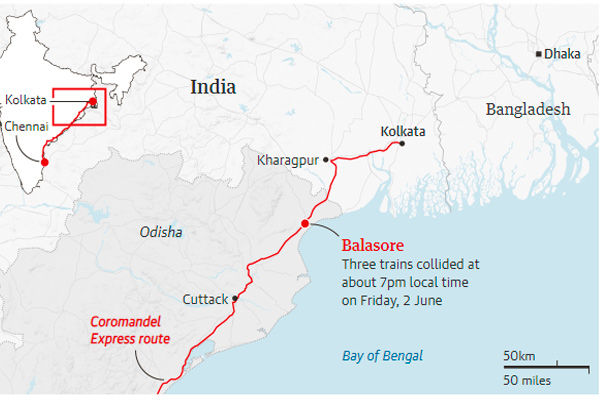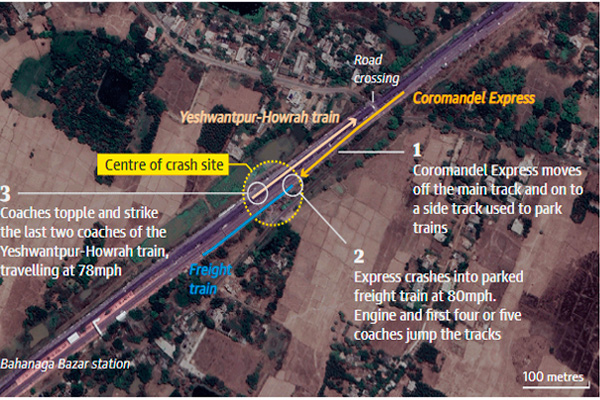The railways minister says the train was diverted onto the incorrect tracks as efforts to clear the devastation continue.
India train crash: According to India’s minister of railways, an error in electronic signals sent a train onto the incorrect tracks, resulting in the country’s bloodiest train accident in over two decades.
Ashwini Vaishnaw stated that the investigation into Friday’s accident in the eastern state of Odisha, in which at least 275 people were killed and more than 1,000 were injured, was still ongoing, but “the root cause has been identified.”
According to preliminary findings, the Coromandel Express train was given a green signal to access the main track line, but it was subsequently removed. The train then entered another track, known as the loop track, and collided with a stationary iron ore-laden freight train.
The collision, which occurred while the Coromandel Express was travelling at 80 mph, was catastrophic. The collision caused the locomotive and the first four or five coaches to leave the tracks, collapse, and collide with the last two coaches of the Bengaluru-Howrah Superfast Express travelling in the opposite direction, causing several carriages of that train to derail as well.
Vaishnaw refused to disclose whether human error or interference contributed to the signalling failure. “An investigation will determine who is responsible and why,” he continued. The railways ministry has also asked the Central Bureau of Investigation, a government agency, to conduct a criminal investigation into the incident.

Two Railway Board officials also verified that the train had been granted a green signal to proceed down the loop track and was not exceeding the speed limit at the time of the collision.
The failure of the track administration system, according to Jaya Varma Sinha, a member of the Railway Board, is the primary focus of investigations. The computer-controlled “interlocking system” used throughout the entire rail network coordinates and controls the signals for inbound trains.
At the location where two tracks intersect, it should automatically divert a train to an empty track, but it appears that this did not occur on Friday. Sinha reported speaking with the motorist, who survived the collision, and confirming that he did not run a red light.
“It should be tamper-proof and error-proof. Sinha explained, “It is known as a failsafe system because even if it fails, the signal will turn red and the train will be stopped.” “However, as is suspected, there was some sort of issue with the system.”
Since Friday, more than one thousand rescuers have been searching for survivors in the aftermath of the collision. On Sunday, after the operation was concluded and all remaining victims were extracted from the debris, the process of clearing the mangled carriages and relaying the tracks commenced so that train service could recommence along one of India’s most heavily travelled rail routes.
“Every dead body has been removed. As he visited the collision site on Sunday, Vaishnaw stated, “Our goal is to complete the restoration work by Wednesday morning so trains can begin operating on this track.”
India train crash: preliminary investigation

Guardian graphic. Image: Google Earth. Source: Preliminary investigation
According to a statement by a senior Odisha state official, the death toll was revised down on Sunday after it was discovered that some carcasses had been tallied twice. The initial death toll estimate was 288.
Early on Sunday morning, five more corpses were brought to a school being used as a mortuary near the accident site, where health workers struggled to deal with the number of decomposing bodies in the heat. Nearly 100 ambulances were used to transport the corpses, many of which had been mutilated beyond recognition, to hospitals and refrigerated storage facilities in Bhubaneswar, the capital of Odisha, until relatives claimed them.
Friday’s incident was the worst since 1995, when 358 people were killed when two trains collided near Delhi. The tragedy has brought attention to the safety of the Indian railways at a time when the prime minister, Narendra Modi, has spent billions on a streamlined modernisation of the British colonial-era railway network, which carries approximately 13 million passengers per day.
In spite of government efforts to improve rail safety, which have reduced fatalities to zero over the past two years, several hundred accidents occur annually on India’s railways, the largest train network under one administration in the world, with derailments accounting for the vast majority.
A 2022 railways report on derailments identified multiple deficiencies in the construction of new tracks and grave lapses in rail safety, while a much-touted anti-collision programme has been implemented on only 2% of India’s railway network.
The Congress opposition party demanded Vaishnaw’s resignation over the incident, accusing the government of “serious deficiencies, criminal negligence, and a complete disregard for safety and security.”
On Saturday, Modi had vowed, “Whoever is discovered to be culpable will receive the harshest punishment possible. They will receive no mercy.”






